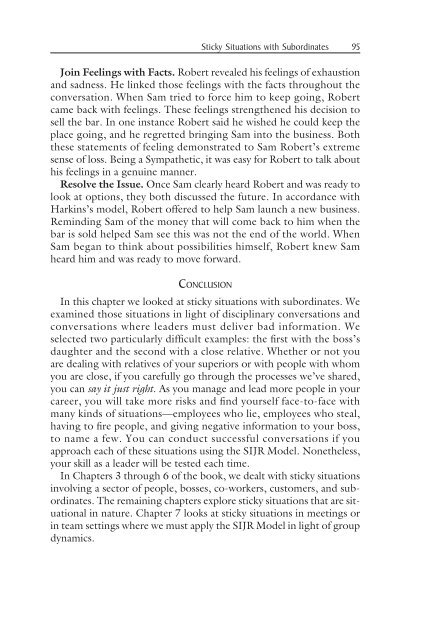Managing Sticky Situations at Work
Managing Sticky Situations at Work
Managing Sticky Situations at Work
Create successful ePaper yourself
Turn your PDF publications into a flip-book with our unique Google optimized e-Paper software.
<strong>Sticky</strong> <strong>Situ<strong>at</strong>ions</strong> with Subordin<strong>at</strong>es 95Join Feelings with Facts. Robert revealed his feelings of exhaustionand sadness. He linked those feelings with the facts throughout theconvers<strong>at</strong>ion. When Sam tried to force him to keep going, Robertcame back with feelings. These feelings strengthened his decision tosell the bar. In one instance Robert said he wished he could keep theplace going, and he regretted bringing Sam into the business. Boththese st<strong>at</strong>ements of feeling demonstr<strong>at</strong>ed to Sam Robert’s extremesense of loss. Being a Symp<strong>at</strong>hetic, it was easy for Robert to talk abouthis feelings in a genuine manner.Resolve the Issue. Once Sam clearly heard Robert and was ready tolook <strong>at</strong> options, they both discussed the future. In accordance withHarkins’s model, Robert offered to help Sam launch a new business.Reminding Sam of the money th<strong>at</strong> will come back to him when thebar is sold helped Sam see this was not the end of the world. WhenSam began to think about possibilities himself, Robert knew Samheard him and was ready to move forward.CONCLUSIONIn this chapter we looked <strong>at</strong> sticky situ<strong>at</strong>ions with subordin<strong>at</strong>es. Weexamined those situ<strong>at</strong>ions in light of disciplinary convers<strong>at</strong>ions andconvers<strong>at</strong>ions where leaders must deliver bad inform<strong>at</strong>ion. Weselected two particularly difficult examples: the first with the boss’sdaughter and the second with a close rel<strong>at</strong>ive. Whether or not youare dealing with rel<strong>at</strong>ives of your superiors or with people with whomyou are close, if you carefully go through the processes we’ve shared,you can say it just right. As you manage and lead more people in yourcareer, you will take more risks and find yourself face-to-face withmany kinds of situ<strong>at</strong>ions—employees who lie, employees who steal,having to fire people, and giving neg<strong>at</strong>ive inform<strong>at</strong>ion to your boss,to name a few. You can conduct successful convers<strong>at</strong>ions if youapproach each of these situ<strong>at</strong>ions using the SIJR Model. Nonetheless,your skill as a leader will be tested each time.In Chapters 3 through 6 of the book, we dealt with sticky situ<strong>at</strong>ionsinvolving a sector of people, bosses, co-workers, customers, and subordin<strong>at</strong>es.The remaining chapters explore sticky situ<strong>at</strong>ions th<strong>at</strong> are situ<strong>at</strong>ionalin n<strong>at</strong>ure. Chapter 7 looks <strong>at</strong> sticky situ<strong>at</strong>ions in meetings orin team settings where we must apply the SIJR Model in light of groupdynamics.















